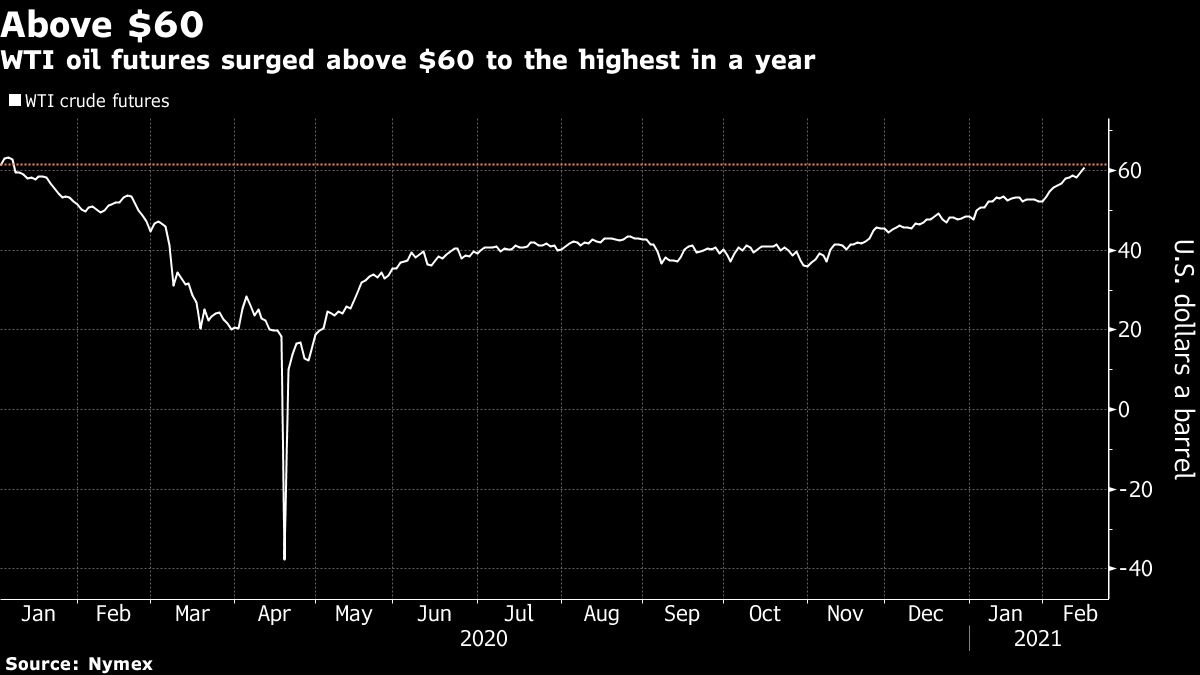Feb 14, 2021
Oil rallies as extreme Texas cold batters U.S. energy markets
, Bloomberg News
McCreath: Oil prices and U.S. 10-year yield rising
Oil rallied to a 13-month high as freezing weather in Texas disrupted flows from America’s largest shale patch, exposing the fragility of global supplies amid sharp OPEC cutbacks.
Trading of West Texas Intermediate futures ended the day up 1.1 per cent, above US$60 a barrel for the first time since January 2020, while Brent in London passed US$63. Permian oil production has fallen by as much as 1 million barrels a day as sub-zero temperatures hit Midland, Texas -- the heart of U.S. shale output. The Arctic blast also threatened to unleash a rush for fuels from propane to heating oil.
But there was a hit to demand too: the largest refinery in the U.S. began shutting down and other plants and pipelines reported issues. With refineries feeling the pressure, the profits in making U.S. oil products like gasoline and diesel jumped.
- U.S. energy crisis deepens with nearly 5 million in the dark
- Biggest oil refineries in U.S. are going dark amid the cold
- Cold weather cuts Permian oil output by 1 million barrels a day
RELATED ITEMS
It’s the latest in a series of cold snaps across the northern hemisphere that have provided a bigger-than-expected boost to oil consumption since the start of the year. And it’s coincided with global oil stockpiles showing signs of declining.
As prices surged, the key North Sea oil market, which helps price more than two-thirds of the world’s crude, also saw its biggest spate of bullish activity in years. Traders lined up to place bids for 20 cargoes in the market, with virtually all of them going unanswered. Swaps markets in the region soared higher after the activity, brokers said.
U.S. crude has climbed about 15 per cent since the start of February, while Brent posted four weeks of gains after Saudi Arabia announced deep output cuts, helping swollen global stockpiles to normalize. That comes amid a “balanced” global oil market, with prices reflecting the current state of play, Russia’s Deputy Prime Minister Alexander Novak said Sunday, underscoring the recovery from the destruction that saw U.S. crude prices briefly turn negative last year.
“This colder-than-usual weather will be around for much of the week, and so should continue to be supportive for both gas and oil prices, particularly if we do see significant supply disruptions,” said Warren Patterson, head of commodities strategy at ING Group.
The cold was so extreme in Texas that the state suffered dramatic power outages as the grid operator grappled with surging demand, and 13 other states also saw blackouts.

Prices
- WTI for March rose 65 cents to US$60.12 a barrel as of 1:33 p.m. New York time
- Trading is now halted until the open on Tuesday due to a U.S. holiday
- Brent for April settlement gained 76 cents to US$63.19
Elsewhere, potential strikes in Norway were adding to supply risks. Equinor ASA warned that union action could lead to shutdowns of its Johan Sverdrup and Troll fields, two of the most significant in the North Sea. Security in the Middle East, meanwhile, was in focus after Saudi Arabian authorities blamed Yemeni rebels for an attack at an airport in the kingdom’s southern region.
Still, concerns remain over the sustainability of crude’s rally. WTI futures’ 14-day Relative Strength Index remains well above 70 in a sign that the commodity is due for a pullback. Meanwhile, the threat of new virus strains and cases in parts of China may cap what’s been a dramatic recovery in fuel consumption, with the International Energy Agency last week cutting its demand forecast for 2021 and describing the market as fragile.
“The cold snap, the additional Saudi cuts, the fresh U.S. stimulus promise are all helping,” said Vandana Hari, founder of Vanda Insights in Singapore. “But the single biggest factor -- and one the doubters have probably been missing or disbelieving -- is that Covid on a global level is in a retreat, for more than four weeks now.”
--With assistance from Dan Murtaugh and Rob Verdonck.




